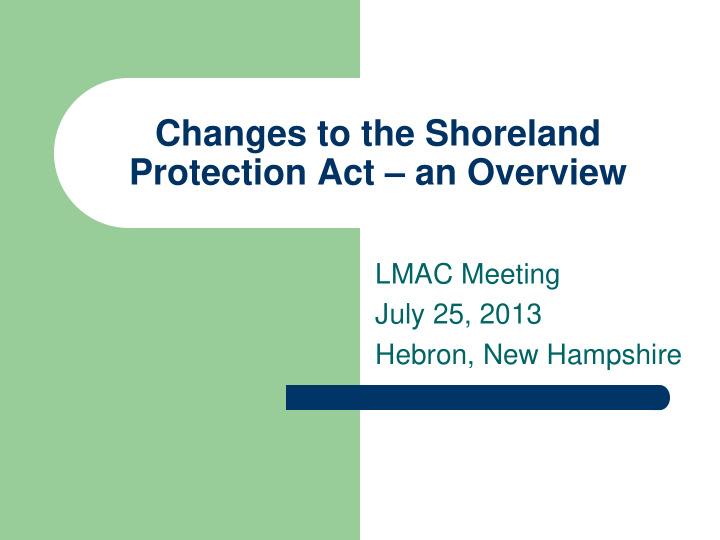



Changes to the Shoreland Protection Act – an Overview LMAC Meeting July 25, 2013 Hebron, New Hampshire
Effective Date � August 27, 2013 � Many of the 2008 buffer requirements have been restored.
Ground Cover Becomes “Natural” � RSA 483-B:4, X-b, relative to the definition of “natural ground cover”, is repealed. � RSA 483-B:4, VII the definition of “Ground Cover” is replaced to read: “…any herbaceous plant or any woody seedling or shrub generally less than 3 feet in height. Ground cover shall not include lawns, landscaped areas, gardens, invasive species …, exotic species …, imported organic or stone mulches, or other artificial materials.” � This is the old natural groundcover definition. This was done to remove conflicts in the definition of the similar terms which had been introduced in separate, earlier, legislative sessions.
Healthy Native Vegetation � Amend RSA 483-B:4,XXIV-b to read: “means native vegetation allowed to grow without cutting, limbing, trimming, pruning, mowing, or other similar activities except as needed for [plant health, normal maintenance, and] renewal or to maintain or improve plant health .” � This restores the focus of protection to native species and moves towards limiting the activities allowed to those beneficial to the vegetation.
DES Has Limited Property Access � Amend RSA 483-B:5, II to read as follows: “The commissioner or his or her designee may, for cause, enter upon any subject land or parcel at any reasonable time [after written notification] , provided he or she has obtained the oral or written permission of the property owner, attempted to notify the property owner or his or her agent either orally or in writing 24 hours prior to entry, or has observed, or received credible evidence of, the occurrence of activities regulated by this chapter that may impact water quality, to perform oversight and enforcement duties provided for in this chapter.” � The most important phrase here is “or has observed, or received credible evidence of, the occurrence of activities regulated by this chapter that may impact water quality….” If we see a violation or receive a credible compliant we can investigate immediately.
Limestone – No Exception � Amend RSA 483-B:9, II(d) to read as follows: “No fertilizer[, except limestone,] shall be applied to vegetation or soils located within 25 feet of the reference line of any public water. Beyond 25 feet, slow or controlled release fertilizer, as defined by rules adopted by department, may be used.” � Members of both the scientific community and regulated public pursued this on the grounds that limestone does degrade water quality.
Tree Cover – More Required Diameter or Caliper – Score � 1 to 3 inches – 1 � Greater than 3 to and including 6 inches – 5 � Greater than 6 to and including 12 inches – 10 � [12 to 24 inches – 15] � Greater than [24] 12 inches – [25] 15 � The points for given tree diameters are lowered thus requiring more trees to be kept within the 50 ft waterfront buffer.
Shrubs Only Count for Planting � (ii) For the purpose of planting under RSA 483-B:9, V(g)(3), shrubs and groundcover plants shall be scored as follows: – Four square feet of shrub area -1 point. – Ground cover [planted in the form of sod or mat] , not including mowed lawn - one point for every 50 square feet. – Shrub and groundcover shall [not] count for at least 15 points and not more than 25 points in each full segment. � Points are only awarded for shrub and ground cover when there is a need to replant or restore a previously disturbed shoreline. Previously, 25 points could be made up using 100 sq ft of pre-existing shrubs, meaning only 25 points worth of trees were needed. Now when counting existing vegetation for the purpose of cutting or determining compliance, all 50 points must be obtained using trees.
Stormwater Management Defined � Amend RSA 483-B:9,V(g)(1) to read as follows:(1) No more than 30 percent of the area of a lot located within the protected shoreland shall be composed of impervious surfaces, unless a stormwater management system designed and certified by a professional engineer [that will not concentrate stormwater runoff or contribute to erosion] is implemented. Such system design shall demonstrate that the post-development volume and peak flow rate based on the 10-year, 24-hour storm event, shall not exceed the pre-development volume and peak flow rate for flow off the property within the protected shoreland. � While the ability to exceed 30% impervious surface coverage remains, this puts significant stormwater management requirements in place where before there were none.
Recommend
More recommend